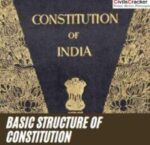
Preamble of the Indian Constitution | Indian Polity notes
Preamble of our constitution is an introductory statement of 73 words which highlights the objectives, essence, core values and principles of the constitution.
Home » UPSC Study Materials » CivilsCracker Explains » Indian Polity Detailed Notes » Union and Its Territory(Part – 1 of the Constitution) | Indian Polity notes
Read in detail about the Union and Its Territory(Part – 1 of the Constitution)
The first part of the Indian Constitution contains Articles 1 to 4. It deals with the Indian Union and its territories.
Let’s study them one and by one.
Article 3 has provided such powers to the parliament so that it can redraw the political map of India according to the demands of time and administrative convenience.
A recent example is the formation of Ladakh as a union territory from the state of Jammu and Kashmir aimed to improve governance and cater to the needs of Ladakh’s people and at the same time highlighting that the unity and integrity of India is paramount.
As the territorial integrity of any Indian state is not guaranteed by the constitution hence India is described as ‘an indestructible union of destructible states’.
As the territorial integrity of the states in the USA is guaranteed by the Constitution, Hence, the USA is described as ‘an indestructible union of indestructible states.’

Preamble of our constitution is an introductory statement of 73 words which highlights the objectives, essence, core values and principles of the constitution.

The concept of ‘Basic Structure of Constitution’ derives its origin from the landmark judgment of Supreme Court of India given in ‘Kesavananda Bharati vs State of Kerala case of 1973.

An Indian citizen residing outside India for a total of at least 183 days in a financial year is considered to be a NRI.

The Regulating Act of 1773 was the first step taken by the British Parliament to regulate the affairs of the East India Company in India.
We are adding new Notes, Chapterwise MCQs, Quizzes, Previous Years Questions everyday
We are adding new Notes, Chapterwise MCQs, Quizzes, Previous Years Questions everyday